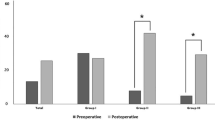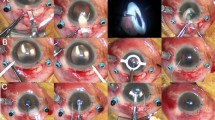Abstract
Purpose
To evaluate corneal endothelial cell density (ECD) in the eyes with different grades of late spontaneous in-the-bag intraocular lens (IOL) dislocation.
Methods
A prospective study included seventy-eight patients who applied for IOL dislocation. Overall 80 eyes were divided into four grades based on the in-the-bag IOL dislocation classification. All eyes underwent a complete ophthalmological examination. ECD was evaluated using in vivo corneal confocal microscopy.
Results
Median corneal ECD was 1929 (1022–2958) cells/mm2 of all the patients. The lowest number of ECD was in grade 2 (grade 1 median ECD 1990.33 (1182–2425.33) cells/mm2, grade 2—1577.0 (1022–2958) cells/mm2, grade 3—2205.84 (1259–2807.67) cells/mm2 and grade 4—2072.17 (1045–2581.0) cells/mm2). A statistically significant difference was observed between the median of ECD of grade 2nd and 3rd (p = 0.023). By grouping cases into those with and without glaucoma, we found that corneal ECD was significantly lower in eyes with glaucoma compared with eyes without glaucoma in grades 3 and 4 (p < 0.05), while in other grades, the difference did not reach the significance level. We divided the corneal ECD of all eyes into two categories ≤ 1500 cells/mm2 and > 1500 cells/mm2. Logistic regression demonstrated that the odds of having corneal ECD less than 1500 cells/mm2 increased by 3.5-fold if patients with IOL dislocation had been diagnosed with glaucoma previously.
Conclusion
Late spontaneous in-the-bag IOL dislocation reduced corneal ECD. Previously diagnosed glaucoma was the most common comorbidity. This condition has a significant impact on corneal ECD for patients with IOL dislocation.



*, ** Kruskal–Wallis test, p < 0.05


*,**,*** Kruskal–Wallis test, p < 0.05

*Kruskal–Wallis test, p < 0.05

*, **Kruskal–Wallis test, p < 0.05
Similar content being viewed by others
Data availability
The data that support the findings of the present study are available from the corresponding author upon reasonable request.
References
Dabrowska-Kloda K, Kloda T, Boudiaf S et al (2015) Incidence and risk factors of late in-the-bag intraocular lens dislocation: evaluation of 140 eyes between 1992 and 2012. J Cataract Refract Surg 41:1376–1382. https://doi.org/10.1016/j.jcrs.2014.10.040
Østern AE, Sandvik GF, Drolsum L (2014) Late in-the-bag intraocular lens dislocation in eyes with pseudoexfoliation syndrome. Acta Ophthalmol 92:184–191. https://doi.org/10.1111/aos.12024
Jakobsson G, Zetterberg M, Lundström M et al (2010) Late dislocation of in-the-bag and out-of-the bag intraocular lenses: ocular and surgical characteristics and time to lens repositioning. J Cataract Refract Surg 36:1637–1644. https://doi.org/10.1016/j.jcrs.2010.04.042
Mönestam EI (2009) Incidence of dislocation of intraocular lenses and pseudophakodonesis 10 years after cataract surgery. Ophthalmology 116:2315–2320. https://doi.org/10.1016/j.ophtha.2009.05.015
Clark A, Morlet N, Ng JQ et al (2011) Whole population trends in complications of cataract surgery over 22 years in Western Australia. Ophthalmology 118:1055–1061. https://doi.org/10.1016/j.ophtha.2010.11.001
Ascaso FJ, Huerva V, Grzybowski A (2015) Epidemiology, etiology, and prevention of late IOL-capsular bag complex dislocation: review of the literature. J Ophthalmol 2015:1–7. https://doi.org/10.1155/2015/805706
Schein OD, Cassard SD, Tielsch JM, Gower EW (2012) Cataract surgery among medicare beneficiaries. Ophthalmic Epidemiol 19:257–64. https://doi.org/10.3109/09286586.2012.698692
Behndig A, Montan P, Stenevi U et al (2011) One million cataract surgeries: Swedish national cataract register 1992–2009. J Cataract Refract Surg 37:1539–1545. https://doi.org/10.1016/j.jcrs.2011.05.021
Lundström M, Goh PP, Henry Y et al (2015) The changing pattern of cataract surgery indications: a 5-year study of 2 cataract surgery databases. Ophthalmology 122:31–38. https://doi.org/10.1016/j.ophtha.2014.07.047
Gollogly HE, Hodge DO et al (2013) Increasing incidence of cataract surgery: population-based study. J Cataract Refract Surg 39:1383–1389. https://doi.org/10.1016/j.jcrs.2013.03.027
Grabska-Liberek I, Michalska-Małecka K, Więckowska B et al (2018) Incidence and characteristics of cataract surgery in poland, during 2010–2015. Int J Environ Res Public Health 15:435. https://doi.org/10.3390/ijerph15030435
Lansingh VC, Nano ME, Carter MJ et al (2014) Complexities and challenges of surgical data collection from cataract patients: comparison of cataract surgery rates between 2001 and 2008 in all provinces of Argentina. Arq Bras Oftalmol 77:25–29. https://doi.org/10.5935/0004-2749.20140008
Wang W, Yan W, Fotis K et al (2016) Cataract surgical rate and socioeconomics: a global study. Investig Ophthalmol Vis Sci 57:5872–5881. https://doi.org/10.1167/iovs.16-19894
Sousa DC, Leal I, Faria MY, Pinto LA (2016) A Rare manifestation of uveitis-glaucoma-hyphema syndrome. J Curr glaucoma Pract 10:76–8. https://doi.org/10.5005/jp-journals-10008-1205
Shingleton BJ, Yang Y, O’Donoghue MW (2013) Management and outcomes of intraocular lens dislocation in patients with pseudoexfoliation. J Cataract Refract Surg 39:984–993. https://doi.org/10.1016/j.jcrs.2013.01.044
Zhang L, Hood CT, Vrabec JP et al (2014) Mechanisms for in-the-bag uveitis-glaucoma-hyphema syndrome. J Cataract Refract Surg 40:490–492. https://doi.org/10.1016/j.jcrs.2013.12.002
Kristianslund O, Råen M, Østern AE, Drolsum L (2017) Glaucoma and intraocular pressure in patients operated for late in-the-bag intraocular lens dislocation: a randomized clinical trial. Am J Ophthalmol 176:219–227. https://doi.org/10.1016/j.ajo.2017.01.026
Edelhauser HF (2006) The balance between corneal transparency and edema: the proctor lecture. Invest Ophthalmol Vis Sci 47:1754–67. https://doi.org/10.1167/iovs.05-1139
Hoffer KJ, Kraff MC (1980) Normal endothelial cell count range. Ophthalmology 87:861–866. https://doi.org/10.1016/S0161-6420(80)35149-X
Laing RA, Sandstrom MM, Berrospi AR, Leibowitz HM (1976) Changes in the corneal endothelium as a function of age. Exp Eye Res 22:587–594. https://doi.org/10.1016/0014-4835(76)90003-8
Hiles DA, Biglan AW, Fetherolf EC (1979) Central corneal endothelial cell counts in children. Am Intra-Ocular Implant Soc J 5:292–300. https://doi.org/10.1016/S0146-2776(79)80078-6
Yee RW, Matsuda M, Schultz RO, Edelhauser HF (1985) Changes in the normal corneal endothelial cellular pattern as a function of age. Curr Eye Res 4:671–678. https://doi.org/10.3109/02713688509017661
Laule A, Cable MK, Hoffman CE, Hanna C (1978) Endothelial cell population changes of human cornea during life. Arch Ophthalmol 96:2031–2035. https://doi.org/10.1001/archopht.1978.03910060419003
Nucci P, Brancato R, Mets MB, Shevell SK (1990) Normal endothelial cell density range in childhood. Arch Ophthalmol 108:247–248. https://doi.org/10.1001/archopht.1990.01070040099039
Møller-Pedersen T (1997) A comparative study of human corneal keratocyte and endothelial cell density during aging. Cornea 16:333–338
Hoffer KJ (2017) Corneal endothelial cell density in children: normative data from birth to 5 years old. Am J Ophthalmol 178:186. https://doi.org/10.1016/j.ajo.2017.02.032
Elbaz U, Mireskandari K, Tehrani N et al (2017) Corneal endothelial cell density in children: normative data from birth to 5 years old. Am J Ophthalmol 173:134–138. https://doi.org/10.1016/j.ajo.2016.09.036
Zheng T, Le Q, Hong J, Xu J (2016) Comparison of human corneal cell density by age and corneal location: an in vivo confocal microscopy study. BMC Ophthalmol 16:1–10. https://doi.org/10.1186/s12886-016-0290-5
Tomaszewski BT, Zalewska R, Mariak Z (2014) Evaluation of the endothelial cell density and the central corneal thickness in pseudoexfoliation syndrome and pseudoexfoliation glaucoma. J Ophthalmol 2014:7. https://doi.org/10.1155/2014/123683
Cho SW, Kim JM, Choi CY, Park KH (2009) Changes in corneal endothelial cell density in patients with normal-tension glaucoma. Jpn J Ophthalmol 53:569–573. https://doi.org/10.1007/s10384-009-0740-1
Alfawaz AM, Holland GN, Yu F et al (2016) Corneal endothelium in patients with anterior uveitis. Ophthalmology 123:1637–1645. https://doi.org/10.1016/j.ophtha.2016.04.036
Örnek N, Örnek K (2018) Corneal endothelial changes following a single session of selective laser trabeculoplasty for pseudoexfoliative glaucoma. Int Ophthalmol 38:2327–2333. https://doi.org/10.1007/s10792-017-0730-0
Østern AE, Drolsum L (2012) Corneal endothelial cells 6–7 years following cataract surgery in patients with pseudoexfoliation syndrome. Acta Ophthalmol 90:408–411. https://doi.org/10.1111/j.1755-3768.2010.02012.x
Lass JH, Benetz BA, Gal RL et al (2013) Donor age and factors related to endothelial cell loss 10 years after penetrating keratoplasty: Specular microscopy ancillary study. Ophthalmology 120:2428–2435. https://doi.org/10.1016/j.ophtha.2013.08.044
Lorente R, De Rojas V, Vazquez De Parga P et al (2010) Management of late spontaneous in-the-bag intraocular lens dislocation: retrospective analysis of 45 cases. J Cataract Refract Surg 36:1270–1282. https://doi.org/10.1016/j.jcrs.2010.01.035
Kristianslund O, Råen M, Østern AE, Drolsum L (2017) Late in-the-bag intraocular lens dislocation: a randomized clinical trial comparing lens repositioning and lens exchange. Ophthalmology 124:151–159. https://doi.org/10.1016/j.ophtha.2016.10.024
Davis D, Brubaker J, Espandar L et al (2009) Late in-the-bag spontaneous intraocular lens dislocation. evaluation of 86 consecutive cases. Ophthalmology 116:664–670. https://doi.org/10.1016/j.ophtha.2008.11.018
De Maria A, Wilmarth PA, David LL, Bassnett S (2017) Proteomic analysis of the bovine and human ciliary zonule. Investig Ophthalmol Vis Sci 58:573–585. https://doi.org/10.1167/iovs.16-20866
Aliò JL, Anania A, Sagnelli P (2008) The aging of the human lens. In: Cavallotti CAP, Cerulli L (ed) Age-related changes of the human eye. Humana Press, Totowa, pp 61–131
Eum SJ, Kim MJ, Kim HK (2016) A Comparison of Clinical Outcomes of Dislocated Intraocular Lens Fixation between In Situ Refixation and Conventional Exchange Technique Combined with Vitrectomy. J Ophthalmol 2016. https://doi.org/10.1155/2016/5942687
Werner L, Zaugg B, Neuhann T et al (2012) In-the-bag capsular tension ring and intraocular lens subluxation or dislocation: a series of 23 cases. Ophthalmology 119:266–271. https://doi.org/10.1016/j.ophtha.2011.08.016
Streilein JW, Okamoto S, Sano Y, Taylor AW (2006) Neural control of ocular immune privilege. Ann N Y Acad Sci 917:297–306. https://doi.org/10.1111/j.1749-6632.2000.tb05396.x
Mo JS, Anderson MG, Gregory M et al (2003) By altering ocular immune privilege, bone marrow-derived cells pathogenically contribute to DBA/2J pigmentary glaucoma. J Exp Med 197:1335–1344. https://doi.org/10.1084/jem.20022041
Ibrahim O, Yagi-Yaguchi Y, Kakisu K et al (2019) Association of iris damage with reduction in corneal endothelial cell density after penetrating keratoplasty. Cornea 38:268–274. https://doi.org/10.1097/ICO.0000000000001819
Yazu H, Yamaguchi T, Tsubota K, Shimazaki J (2019) Clinical factors for rapid endothelial cell loss after corneal transplantation: novel findings from the aqueous humor. Curr Ophthalmol Rep 7:89–97. https://doi.org/10.1007/s40135-019-00204-1
Yagi-Yaguchi Y, Yamaguchi T, Higa K et al (2017) Association between corneal endothelial cell densities and elevated cytokine levels in the aqueous humor. Sci Rep 7:1–8. https://doi.org/10.1038/s41598-017-14131-3
Bulnes BL, de Rojas Silva MV, Moore RL (2019) Intraocular pressure changes before and after surgery for spontaneous in-the-bag intraocular lens dislocation. J Cataract Refract Surg 45:305–311. https://doi.org/10.1016/j.jcrs.2018.10.038
Bryant TK, Feinberg EE, Peeler CE (2017) Uveitis-glaucoma-hyphema syndrome secondary to a soemmerring ring. J Cataract Refract Surg 43:985–987. https://doi.org/10.1016/j.jcrs.2017.07.002
Shingleton BJ, Neo YN, Cvintal V et al (2017) Outcome of phacoemulsification and intraocular lens implantion in eyes with pseudoexfoliation and weak zonules. Acta Ophthalmol 95:182–187. https://doi.org/10.1111/aos.13110
Østern AE, Sandvik GF, Drolsum L (2014) Positioning of the posterior intraocular lens in the longer term following cataract surgery in eyes with and without pseudoexfoliation syndrome. Acta Ophthalmol 92:253–258. https://doi.org/10.1111/aos.12025
Jakobsson G, Zetterberg M, Sundelin K, Stenevi U (2013) Surgical repositioning of intraocular lenses after late dislocation: complications, effect on intraocular pressure, and visual outcomes. J Cataract Refract Surg. https://doi.org/10.1016/j.jcrs.2013.06.023
Doors M, Berendschot TTJM, Webers CAB, Nuijts RMMA (2010) Model to predict endothelial cell loss after iris-fixated phakic intraocular lens implantation. Investig Ophthalmol Vis Sci 51:811–815. https://doi.org/10.1167/iovs.09-3981
Janson BJ, Alward WL, Kwon YH et al (2018) Glaucoma-associated corneal endothelial cell damage: a review. Surv Ophthalmol 63:500–506. https://doi.org/10.1016/j.survophthal.2017.11.002
de Juan-Marcos L, Cabrillo-Estévez L, Escudero-Domínguez FA et al (2013) Morphometric changes of corneal endothelial cells in pseudoexfoliation syndrome and pseudoexfoliation glaucoma. Arch la Soc Española Oftalmol 88:439–444. https://doi.org/10.1016/j.oftale.2013.11.008
Gagnon MM, Boisjoly HM, Brunette I, Charest MAM (1997) Corneal endothelial cell density in glaucoma. Cornea 16(3):314–318
Sihota R, Lakshmaiah NC, Titiyal JS et al (2003) Corneal endothelial status in the subtypes of primary angle closure glaucoma. Clin Exp Ophthalmol 31:492–495. https://doi.org/10.1046/j.1442-9071.2003.00710.x
Acknowledgements
The authors would like to thank Irena Nedzelskiene (Lithuanian University of Health Sciences, Medical Academy, Department of Dental and Oral Pathology) for help in statistical analysis and Audrius Liutkus for help in preparing illustrations.
Funding
The authors have no funding received for this work to disclose.
Author information
Authors and Affiliations
Contributions
RV and JV were involved in the design and conduct of the study, in the collection, management, analysis, and interpretation of data, and in preparation, review and final approval of the manuscript.
Corresponding author
Ethics declarations
Conflicts of interest
The authors declare that they have no conflicts of interest
Ethical approval
All procedures performed in studies involving human participants were in accordance with the ethical standards of the national research committee and with the 1964 Helsinki declaration and its later amendments.
Informed consent
Informed consent was obtained from all individual participants included in the study.
Additional information
Publisher's Note
Springer Nature remains neutral with regard to jurisdictional claims in published maps and institutional affiliations.
Rights and permissions
About this article
Cite this article
Vaiciuliene, R., Jasinskas, V. Corneal endothelial status in different grades of late spontaneous in-the-bag IOL dislocation. Int Ophthalmol 41, 1625–1634 (2021). https://doi.org/10.1007/s10792-021-01702-7
Received:
Accepted:
Published:
Issue Date:
DOI: https://doi.org/10.1007/s10792-021-01702-7




